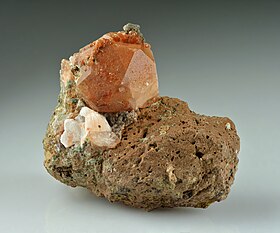Analcime
| Analcime | |
|---|---|
 Reddish crystals of analcime up to 1.8 cm in size on matrix | |
| General | |
| Category | Zeolite |
| Formula (repeating unit) | NaAlSi2O6·H2O |
| IMA symbol | Anl[1] |
| Strunz classification | 9.GB.05 |
| Crystal system | Orthorhombic |
| Crystal class | Dipyramidal (mmm) H-M symbol: (2/m 2/m 2/m) |
| Space group | Ibca |
| Identification | |
| Color | White, colorless, gray, pink, greenish, yellowish |
| Crystal habit | Typically in crystals, usually trapezohedrons, also massive to granular. |
| Twinning | Polysynthetic on [001], [110] |
| Cleavage | Very poor [100] |
| Fracture | Uneven to subconchoidal |
| Mohs scale hardness | 5 - 5.5 |
| Luster | Vitreous |
| Streak | White |
| Specific gravity | 2.24 - 2.29 |
| Optical properties | Isotropic; anomalously biaxial (-) |
| Refractive index | n = 1.479 - 1.493 |
| Fusibility | 3.5 |
| Other characteristics | Weakly piezoelectric; weakly electrostatic when rubbed or heated. |
| References | [2] |
Analcime (/əˈnælsiːm, -saɪm/; from Ancient Greek ἀνάλκιμος (análkimos) 'not strong') or analcite is a white, gray, or colorless tectosilicate mineral. Analcime consists of hydrated sodium aluminium silicate in cubic crystalline form. Its chemical formula is NaAlSi2O6·H2O. Minor amounts of potassium and calcium substitute for sodium. A silver-bearing synthetic variety also exists (Ag-analcite).
Analcime is usually classified as a zeolite mineral, but structurally and chemically it is more similar to the feldspathoids. Analcime occurs as a primary mineral in analcime basalt and other alkaline igneous rocks. It also occurs as cavity and vesicle fillings associated with prehnite, calcite, and zeolites.
Locations
Well known locations for sourcing analcime include Croft Quarry in Leicestershire, UK; the Cyclopean Islands east off Sicily and near Trentino in northern Italy; Victoria in Australia; Kerguelen Island in the Indian Ocean; in the Lake Superior copper district of Michigan, Bergen Hill, New Jersey, Golden, Colorado, and at Searles Lake, California in the United States; and at Cape Blomidon, Nova Scotia and Mont Saint-Hilaire, Quebec[3] in Canada; and in Iceland, and now in Namibia.
Analcime forms in sedimentary rocks at temperatures below about 100 °C (212 °F), and so its presence indicates that the rock has experienced shallow diagenesis.[4]
See also
- List of minerals – List of minerals with Wikipedia articles
References
- ^ Warr, L.N. (2021). "IMA–CNMNC approved mineral symbols". Mineralogical Magazine. 85 (3): 291–320. Bibcode:2021MinM...85..291W. doi:10.1180/mgm.2021.43. S2CID 235729616.
- ^ Handbook of Mineralogy, Mineral Data Publishing
- ^ Normand, Charles; Tarassoff, Peter (2006). Mineralogy and geology of the Poudrette quarry, Mont SaintHilaire, Quebec (PDF). Mineralogical Association of Canada. Archived (PDF) from the original on 2022-10-09. Retrieved 12 March 2022.
- ^ Prothero, Donald R.; Schwab, Fred (2004). Sedimentary geology : an introduction to sedimentary rocks and stratigraphy (2nd ed.). New York: W.H. Freeman. p. 124. ISBN 0716739054.
- Hurlbut, Cornelius S.; Klein, Cornelis, 1985, Manual of Mineralogy, 20th ed., ISBN 0-471-80580-7
- Mineral Galleries
- Mindat.org
- Webmineral.com
